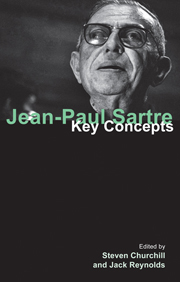Book contents
- Frontmatter
- Contents
- Contributors
- Acknowledgements
- Note on abbreviations
- 1 Introduction: Sartre vivant
- 2 Life and works
- Part I PSYCHOLOGY, PSYCHOANALYSIS AND LITERATURE
- Part II ONTOLOGY: FREEDOM, AUTHENTICITY AND SELF-CREATION
- 8 Nothingness and negation
- 9 The look
- 10 Bad faith
- 11 Authenticity
- 12 Knowledge
- 13 The fundamental project
- 14 Self-making and alienation: from bad faith to revolution
- Part III ETHICS AND POLITICS
- Bibliography
- Index
8 - Nothingness and negation
from Part II - ONTOLOGY: FREEDOM, AUTHENTICITY AND SELF-CREATION
- Frontmatter
- Contents
- Contributors
- Acknowledgements
- Note on abbreviations
- 1 Introduction: Sartre vivant
- 2 Life and works
- Part I PSYCHOLOGY, PSYCHOANALYSIS AND LITERATURE
- Part II ONTOLOGY: FREEDOM, AUTHENTICITY AND SELF-CREATION
- 8 Nothingness and negation
- 9 The look
- 10 Bad faith
- 11 Authenticity
- 12 Knowledge
- 13 The fundamental project
- 14 Self-making and alienation: from bad faith to revolution
- Part III ETHICS AND POLITICS
- Bibliography
- Index
Summary
Although the title of Being and Nothingness registers the importance of the concept of nothingness (le néant) to Sartre's major philosophical book, it would be a mistake to think that nothingness only entered his philosophical thinking – or writing – in 1943. The concept appears frequently, with some variations, in Sartre's earlier “phenomenological” essays.
In The Imaginary (L'Imaginaire), Sartre's 1940 study of the imagination, the concept of nothingness, and the concepts associated with it – negation, denial, annihilation, nothing – play an essential role (Sartre 1940, 2004a). A principal aim of that work is to reject an influential philosophical conception of imagination as a capacity to entertain mental images, where these are conceived as immanent states of consciousness that are similar in type to sensations. Sartre argues cogently against that view (of which the best-known proponent is probably David Hume), putting forward a number of objections to the very idea that imagination involves the presence of “images” to the mind. Sartre argues instead that imaginative activity involves a relationship to the imagined object that requires a radical break, on the part of consciousness, with the world. In addition, he denies the existence of any “images” in the mind. Instead we are to understand that the imagining consciousness, like consciousness in general, is directed to an object. But the objects with which the exercise of the imagination puts us in contact are unreal.
- Type
- Chapter
- Information
- Jean-Paul SartreKey Concepts, pp. 93 - 105Publisher: Acumen PublishingPrint publication year: 2013



